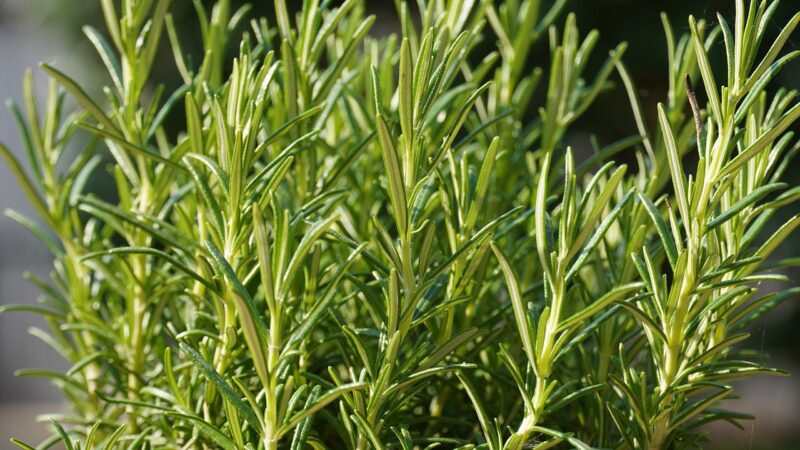Diseases and pests of rosemary

Rosemary is renowned for its resilience and its naturally pest-repellent aromatic oils, making it a relatively low-maintenance addition to the garden. However, it is not entirely invulnerable to health issues. The most significant threats to rosemary are not typically insects, but rather environmental and cultural conditions that lead to fungal diseases. Problems almost always stem from a small number of core issues: excessive moisture, poor air circulation, and inadequate sunlight. Understanding these vulnerabilities is key to preventing problems before they start, as a healthy, unstressed plant is far more capable of fending off both diseases and the occasional pest infestation. Vigilance and proactive care are the best tools for keeping your rosemary vibrant and trouble-free.
Fungal diseases: the primary threat
The most prevalent health issues for rosemary are fungal diseases, which thrive in conditions of high humidity and poor air circulation. Powdery mildew is one of the most common culprits, appearing as a distinctive white or grey powdery coating on the surfaces of the leaves and stems. While it may not be immediately fatal, a severe infection can impede photosynthesis, weaken the plant, cause leaf distortion and drop, and ultimately lead to its decline. This disease is particularly common on rosemary plants that are grown indoors over the winter or are planted too densely in a humid garden setting.
Prevention is by far the most effective strategy against powdery mildew. This begins with providing the plant with its ideal growing conditions, especially full sun and excellent air circulation. When planting multiple rosemary shrubs, ensure they are spaced far enough apart to allow air to move freely between them. For established plants, selective pruning to thin out the center of the shrub can significantly improve air movement through the foliage. Avoid overhead watering, as wet leaves create a perfect environment for fungal spores to germinate and spread.
If you do notice the early signs of powdery mildew, there are several steps you can take to manage it. First, prune off and dispose of the most heavily infected parts of the plant to reduce the number of fungal spores. Be sure to clean your pruning tools afterwards to prevent spreading the disease. For treatment, you can use horticultural oils, such as neem oil, or a fungicide specifically formulated for powdery mildew. An effective homemade remedy involves spraying the plant with a solution of one tablespoon of baking soda and a half teaspoon of liquid soap mixed in a gallon of water.
Improving the plant’s environment is also a critical part of treatment. If the plant is in a container, move it to a location that receives more direct sunlight and has better airflow. For indoor plants, running a small fan for a few hours each day can make a significant difference. By addressing the underlying environmental conditions that allowed the fungus to take hold, you can prevent future outbreaks and help the plant recover its vigor.
More articles on this topic
Understanding and preventing root rot
Root rot is the most serious and often fatal disease that can affect rosemary, and it is almost exclusively caused by overwatering and soil that does not drain properly. The disease is caused by various soil-borne fungi that thrive in anaerobic, or low-oxygen, conditions created by waterlogged soil. These pathogens attack the plant’s root system, causing it to decay and turn black and mushy. Once the roots are damaged, they are no longer able to absorb the water and nutrients the plant needs to survive, leading to a rapid decline in the plant’s health.
The above-ground symptoms of root rot can be deceptive, often resembling those of a plant that is not receiving enough water. The leaves may turn yellow or brown, the stems may become limp, and the entire plant may appear wilted. The key difference is that with root rot, these symptoms occur even when the soil is wet. If you suspect root rot, you can gently remove the plant from its pot or dig around the base to inspect the roots. Healthy rosemary roots should be firm and off-white, while rotted roots will be dark, soft, and may have a foul odor.
Prevention is the only reliable cure for root rot, as it is extremely difficult to save a plant once a significant portion of its root system has been affected. The foundation of prevention lies in providing exceptionally well-draining soil. Whether planting in the ground or in a container, amend the soil with materials like sand, perlite, or fine gravel to ensure that water can move through it quickly. For containers, always choose a pot with multiple drainage holes and use a potting mix designed for cacti and succulents.
Proper watering technique is the other critical component of preventing root rot. Always allow the soil to dry out completely in the top few inches before watering again. Water deeply and thoroughly, but then allow all excess water to drain away. Never let a potted plant sit in a saucer filled with water, as this is a direct invitation for root rot to develop. It is always safer to err on the side of underwatering rosemary rather than overwatering it.
More articles on this topic
Common insect pests
Although rosemary’s strong scent deters many common garden pests, it can occasionally be targeted by a few specific insects, especially when the plant is stressed or grown indoors. Aphids are small, pear-shaped insects that use their piercing mouthparts to suck sap from the tender new growth of the plant. They often congregate in clusters on the tips of stems and the undersides of leaves. A heavy infestation can cause new growth to be stunted or distorted and can lead to the development of sooty mold, a black fungus that grows on the sticky “honeydew” that aphids excrete.
Spider mites are another pest that can become a problem, particularly in the hot, dry conditions often found indoors during the winter. These tiny arachnids are difficult to see with the naked eye, but their presence is often revealed by the fine, delicate webbing they spin on the plant, typically between stems and leaves. They also feed by sucking sap from the leaves, which can cause a stippled or speckled appearance as the individual cells die. A severe infestation can cause leaves to turn yellow or bronze and eventually drop off.
Spittlebugs are another insect occasionally seen on rosemary, though they are more of a cosmetic issue than a serious threat to the plant’s health. The presence of spittlebugs is easily identified by the foamy, saliva-like masses they create on the stems of the plant. Inside this “spittle,” the immature nymph of the insect is feeding on the plant’s sap. While the foam can be unsightly, the feeding activity of a few spittlebugs rarely causes any significant damage to a healthy rosemary plant.
Managing these insect pests usually starts with the simplest and least toxic methods. For aphids and spittlebugs, a strong spray of water from a hose is often enough to dislodge them from the plant. If the infestation is more persistent, you can turn to treatments like insecticidal soap or neem oil. These products work by suffocating the insects and are generally safe for use on edible herbs, but you should always read and follow the label instructions carefully. Ensuring your plant is healthy and not stressed is also a key part of pest prevention, as vigorous plants are better able to withstand and deter insect attacks.
Botrytis blight and other fungal issues
Botrytis blight, also known as gray mold, is another fungal disease that can affect rosemary, particularly in cool, damp, and humid conditions. This disease typically attacks areas of the plant that are already weakened, damaged, or senescing, such as old flowers or dying leaves. It manifests as a fuzzy, grayish-brown mold and can cause parts of the plant, such as stem tips, to wilt and die back. As with other fungal diseases, the key to prevention is to improve air circulation and reduce humidity around the plant.
To prevent botrytis blight, it is important to practice good garden sanitation. Promptly remove any dead or dying leaves and spent flowers from the plant and the surrounding soil surface, as this decaying organic matter provides a perfect breeding ground for the fungus. Pruning to thin out dense foliage will improve air circulation, allowing the leaves and stems to dry more quickly after rain or watering. Watering at the base of the plant in the morning, rather than overhead in the evening, also helps to ensure the foliage remains as dry as possible.
In addition to powdery mildew and botrytis, rosemary can also be susceptible to other less common fungal leaf spot diseases. These typically appear as small, dark spots on the leaves, which may enlarge over time and sometimes develop a yellow halo around them. While generally not a serious threat to the plant’s overall health, they can be unsightly. The control measures are the same as for other fungal issues: improve air circulation, avoid wet foliage, and remove and destroy any heavily infected leaves to prevent the spread of the disease.
The overarching theme in combating all fungal diseases in rosemary is to create an environment that is inhospitable to them. Fungi thrive in moisture and stagnant air, which is the opposite of the sunny, dry, and breezy conditions that rosemary loves. By focusing on providing the plant with its ideal growing environment, you are simultaneously creating the strongest possible defense against the most common diseases that can affect it. A healthy plant in the right location is naturally disease-resistant.
Environmental stress factors
Beyond specific pests and diseases, rosemary can also suffer from a range of problems caused by environmental stress. These issues are often the root cause that weakens a plant, making it more susceptible to secondary infections from fungi or attacks by insects. One of the most common stressors is improper light exposure. A rosemary plant that does not receive at least six hours of direct sun will become weak and leggy, with sparse foliage and poor overall vigor, making it an easy target for problems.
Extreme temperatures can also cause stress. While rosemary is heat-tolerant, extremely high temperatures combined with intense sun can sometimes lead to sunscald on the leaves, especially if the plant is not well-hydrated. More significantly, most rosemary varieties are not tolerant of severe cold. When exposed to temperatures below their hardiness rating, they can suffer from frost damage, which appears as blackened or browned foliage. In cold climates, providing adequate winter protection or bringing the plant indoors is essential to prevent this type of damage.
Soil-related stress is another major factor, stemming from either poor drainage or an incorrect pH. As has been emphasized, soil that remains wet will lead to root suffocation and decay. On the other hand, soil that is excessively sandy and dries out too quickly can also stress the plant, especially if it is not watered adequately during its establishment phase. An imbalanced soil pH can also cause problems by making it difficult for the plant to absorb essential nutrients, leading to deficiencies and poor health even if the nutrients are physically present in the soil.
Transplant shock is a common stressor for newly planted or repotted rosemary. The process of moving a plant can damage its delicate root hairs, temporarily impairing its ability to take up water. Symptoms of transplant shock include wilting, yellowing leaves, and leaf drop. To minimize this stress, handle the root ball as gently as possible during planting, water the plant thoroughly after it is in its new location, and avoid fertilizing it for several weeks to give it time to recover and establish new roots.



















